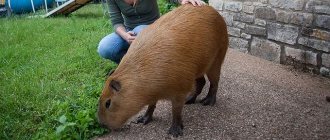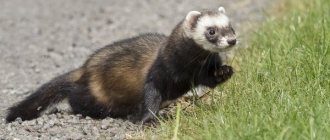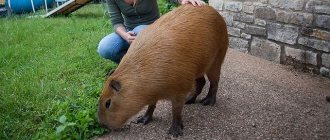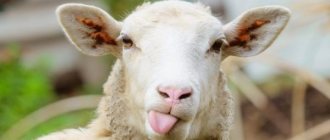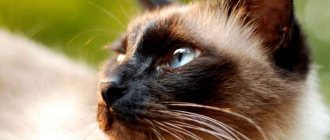- home
- Kinds
14.05.2018
These days, hamsters are as common pets as dogs, cats or aquarium fish. With their antics and preferences, small rodents can cheer up their owners no worse than large animals. With good grooming and care from the owners, the “fluffies” make true friends. However, when buying an animal, it is important to know what types of hamsters there are, since belonging to a particular species of rodent requires the owners to know small nuances in keeping a pet. The character and habits of the “fluffy” also depend on the breed of hamster. Breeds of hamsters with photographs and names can be viewed below.
Syrian hamsters
The Syrian hamster (sometimes referred to as the royal or golden) is one of the most popular breeds for keeping at home. Both adults and children like the rodent. Representatives of this species have a calm character, love affection and are easy to train. They are in good health, rarely get sick, but live on average about two years.
Syrians are one of the largest rodents, growing up to 18 centimeters in length and weighing from 100 to 200 grams. They usually have a golden coat color, but black, gray and beige individuals are also found. They have a small short muzzle, black eyes and a tiny tail.
“Syrians” quickly get used to their owners and can respond to their name. They are easy to care for, since the animals themselves determine those areas in the cage where they have a “bedroom” and a “toilet.”
Fleas, lice, food eaters
Nowadays, a hamster with fleas and lice is a very rare occurrence. And yet, if your pet suffers such a fate, then the most effective method of combating these parasites is contact poison in the form of drops or sprays. Also, baths based on bromocyclene (5 percent solution) have proven themselves well as therapeutic and preventive measures.
But before you bathe your pet in such “medicinal” water, you should familiarize yourself with the rules for bathing hamsters in regular water, because there are a lot of nuances and recommendations that can help you avoid dangerous situations.
Take care of your pets and be happy!
Angora hamsters
When learning about hamsters, it is important to remember that the Angora rodent breed does not exist. “Angorians” are mainly called representatives of the “male” tribe of Syrian hamsters. Their distinctive feature is long fur, fluffy and pleasant to the touch. In males, the length of the fur is up to 5 centimeters; in females it is rarely more than 2 centimeters.
The shaggy rodent requires more careful care than the ordinary Syrian. It is advisable to use litter as bedding in his cage rather than shavings or sawdust, since long fur tends to accumulate more debris than short fur. To care for the Angora's appearance, you can buy a special comb or use an old toothbrush.
Cystitis
Inflammation of the bladder or cystitis often occurs from hypothermia. Rodents do not have good thermoregulation, so even an ordinary draft can provoke it.
The most important rule is to protect your pet from hypothermia:
- hide it from the fan and open windows;
- remember its sensitivity to temperature changes;
- protect from drafts.
Simple rules, but how many difficulties can be avoided by simply closing the window in time! With cystitis, a hamster experiences a burning sensation when urinating and constant pain in the lower abdomen. He won’t be able to talk about it, but it’s possible to find out about the disease. As with colibacillosis, cystitis makes the hamster's fur wet. Losing fluid in such quantities can lead to dehydration.
It is because of the similarity of symptoms that you need to seek a final diagnosis from a specialist. If you suspect inflammation of the bladder, you should immediately go to a veterinary hospital, where they will tell you exactly what happened to your pet. Typically, for cystitis, your veterinarian will prescribe antibiotic treatment. To prevent this, it is better to take care of your pet’s health in advance.
Djungarian hamsters
Dzhungarik is the most popular representative of domestic hamsters. Rodents of this species are small in size and have a good-natured character. They quickly get used to people, are happy to be handled and hardly bite. However, despite all the positive characteristics, the dwarf “jungarik” is not the best choice for a small child. The fact is that due to the small size of the animal’s body, its bones are very fragile; these little ones cannot be squeezed or squeezed in the palms of your hands. However, with proper care and care from their owners, Djungarian hamsters live on average about 3 years.
You can recognize the dzhungarika by the following characteristics: length no more than 10 centimeters, weight up to 50 grams, there is a dark stripe on the back that turns into a diamond in the forehead area. The color of the dzungarian fur coat can be different: from white to dark gray tones (black and brown are also found).
It is advisable to keep representatives of this breed separately from each other. Same-sex couples do not get along well in the same territory, and a pair of “fluffies” will constantly increase the number of rodents, causing unnecessary trouble for the owners. Dzungariki are very clean and emit almost no odor.
How to contact?
Gaining trust will take patience and time. All the efforts expended will subsequently be more than repaid, since the pet will soon begin to show affection and boundless trust. So, what not to do:
- make rough and sudden movements with your hands close to your pet;
- pick up a sleeping or recently awakened animal;
- cover with your palms, trying to catch;
- make loud noises near the cage;
- leave the rodent on high ground;
- grab the scruff of the neck with your fingers;
- Trying to introduce a furry cat to a cat would be a fatal mistake.
It is recommended to constantly talk to the animal, give treats from your hands and treat it affectionately.
It is important to handle your small pet with care and caution. You should take care of a comfortable living environment: do not leave the cage in a hot or cold place, clean it in a timely manner, change the water, add food
Campbell's hamsters
Another representative of the dwarf rodent species is the Campbell's hamster. Rodents of this breed are often confused with dzhungarikas, but they have a distinctive feature, the absence of hair on the hind legs and stripes on the sides. The Campbell's color is dominated by sand, brown and cream tones. Photos of hamsters allow us to see that “Djungarians” and “Kampbs” are two different species, the “striped” Djungarian rodent is only similar in size to its relative.
Unlike other types of rodents, the Campbell's hamster is more wild and difficult to tame. This dwarf “fluffy” can bite its owner’s fingers and does not get along well with other neighbors.
Stressful situation
When stressed, hamsters work hard with their scent glands and, due to this intensity, begin to lose their thick fur. Hamsters are loners, leading an active nocturnal lifestyle. Intrusive imposition of your attention, changing rhythms with interruption of sleep during the day, loud screams of people, sounds of audio systems can bring severe discomfort to your pets.
Perhaps you have moved, or just bought your pet. Give him time to adapt so that he understands that there is nothing in danger for him here. Don't pick him up for a while. Let him get used to it.
Taylor
Taylor is the most decorative of all types of domestic rodents. This miniature pet grows to a maximum of 8 centimeters. However, the main feature of this breed is that the female and male care for their offspring together, which is quite a rare occurrence for hamsters. For livestock breeders planning to keep a couple of pets, this is one of the best options.
Another characteristic feature of this species is that they often bite. The animal can bite the “feeding” hand at the most inopportune moment, so it is not advisable to give representatives of the breed to children of preschool age. When caring for a pet, it is advisable to use a special glove.
Peculiarities
The hamster belongs to the order of rodents - these are small animals with short legs and tails, as well as small ears. Despite the fact that there are about 19 species, they are all similar to each other, and differ only in size and color, which depend on their habitat. Thus, the inhabitants of the desert plains received yellow or sandy fur. Hamsters living in the forest-steppe zone got a brown or gray skin. And rocks have black or dark brown fur. This allows tiny animals to safely camouflage themselves from attacks by aerial predators.
Nature has endowed hamsters with sharp and strong teeth - this allows them to cope with hard food such as nuts and grains. The animal has only 4 teeth, which grow throughout its life. Therefore, when kept at home, he needs a special mineral stone on which he will grind his teeth.
The hamster's diet is quite extensive, it includes:
- cereals and legumes;
- vegetables;
- fruits;
- roots;
- herbs;
- berries;
- nuts;
- seeds.
Some species, such as the Transbaikal and rat-like hamsters, also feed on insects and carrion. In the natural environment, a hamster has access to food only in the summer-autumn period, so an animal of any breed will definitely stock up for future use. To do this, he has special cheek pouches that allow him to store food and transfer supplies to storage.
So, we can conclude that a hamster needs a fairly rich diet to provide the body with the necessary elements. As the basis of a pet’s diet, a special food mixture, additionally enriched with vitamins, is perfect. In summer, hamsters need to receive fresh vegetables, fruits, berries and herbs. Suitable for this:
- carrot;
- broccoli;
- radish;
- apples;
- pears;
- apricots;
- strawberry;
- blueberry;
- currant;
- dandelion;
- clover;
- lettuce leaves.
Proper nutrition plays an important role in the well-being of your pet. Under no circumstances should you give your hamster dairy products, sweet baked goods, or certain types of vegetables and fruits. Here is a list of foods prohibited for pet rodents.
- Dairy products (sour cream, yogurt, milk, kefir). They can cause indigestion, which can be fatal for your hamster.
- Flour products (bread, rolls). Such food leads to diseases of internal organs and can cause bloating.
- White cabbage. Its use threatens poisoning and intestinal upset.
- Citrus fruit. Tangerines and oranges can cause allergic reactions and even cancer.
Hamsters are accustomed to getting the required amount of water from food, because in their natural habitat they rarely have access to a water source. However, having a water bowl in your pet’s cage is still necessary. Depending on the air temperature and the food received, the rodent will be able to obtain additional moisture if necessary.
Wild rodents are territorial animals; they live alone in underground burrows. Therefore, two individuals of the same sex will not be able to get along in the same cage. Hamsters are nocturnal. In their natural environment, at night they go in search of food - this way the animal is less likely to fall into the clutches of a predator, such as a weasel or a heron. Be prepared for your pet to spend most of the night spinning the wheel and rustling sawdust.
Radde
The Radde breed (Dagestan or Cis-Caucasian hamster) is not often found in the homes of animal lovers. This rodent is more accustomed to the wild, lives in burrows and rarely emerges from its hiding places during daylight hours. It is not suitable for keeping at home, since it is often a carrier of various diseases that are dangerous both to other animals and to humans.
Radde's hamsters are one of the largest, some individuals grow up to 28 centimeters. As a rule, the coat of these rodents is brown interspersed with light and dark spots.
If a Radde hamster has already appeared in the house, then you will have to make every effort to tame it. However, any attempts to switch a nocturnal rodent to wakefulness during the daytime are fraught with negative consequences.
Allergy
Allergies can be food or contact. A food problem occurs when improper feeding occurs, when the hamster receives food “from the table” - sweet food, nuts, strawberries and other exotic delicacies. Contact – for household chemicals, filler (coniferous sawdust). If the animal sits in the owner's arms, it may be allergic to perfume.
When allergies occur, not only the animal’s skin is affected - the ears turn red, transparent discharge appears from the eyes and nose, and the animal may sneeze.
Treatment does not require the use of antihistamines; it is enough to identify and remove the cause. The bedding is replaced with white paper napkins, and all excesses are removed from the diet.
Roborovsky's hamster
Among the smallest representatives of the domestic rodent species is the Roborovsky hamster. Adults grow up to 4-5 centimeters. They differ from the Djungarians by the absence of a stripe on the back and a diamond on the head, and they also have rather long legs. Another distinctive feature of this breed is the “eyebrows” in the form of small spots above the eyes.
Roborovsky's hamster is not suitable for solitary living; he prefers to live in small colonies with a leader at the head. They are difficult to train, but very nimble and agile. If such a rodent runs away from its designated home, it will not be easy to catch it.
When characterizing the types of hamsters, it is worth noting that the Roborovsky hamster has the most nervous disposition. Any rearrangement in the cage causes stress in the animal, which lasts for several days.
Its bites are the least dangerous for humans, since the hamster cannot even bite through the skin with its tiny teeth.
Duration and lifestyle
In their natural environment, wild hamsters live no longer than 4 years. Steppe rodents lead a solitary lifestyle and jealously guard their possessions. The peak activity of karbysh occurs at night. During the day, steppe animals sit in burrows.
Field hamsters are not afraid of low temperatures and harsh climates. With the onset of cold weather, wild rodents hibernate. Karbysh hibernate in a shallow earthen burrow and sometimes awaken to feed.
The steppe and forest hamster gets to the surface only after the snow has completely melted. The males are the first to leave their homes, and a little later the females follow their example.
For burrows, steppe and forest hamsters adapt ready-made tunnels that were dug by gophers and other animals. Rodents usually seek out and modernize abandoned homes. But if necessary, the karbysh easily kick out the owners.
The burrows of steppe hamsters are arranged in a very interesting way. They consist of several rooms and nests, which are lined with dry grass. The depth of hamster dwellings can reach 1.5 m, and the width - up to 8 m. Each burrow has about a dozen exits, some of which are false.
Other types
Rodents called “long-tailed hamster” are sometimes found in pet stores and markets. With a body length of 10 centimeters, such animals also have a tail about 4 centimeters long. They have dark gray fur on the back, a light belly and a white edge near the ears.
Sometimes sellers try to sell an albino hamster as a separate breed. It is important to know that a representative of any species bred at home can have white fur and red eyes, and not just a “thoroughbred” specimen.
Sometimes, under the guise of a large hamster, expensive pet stores try to sell an animal such as a capybara, but this rodent has nothing to do with these rodents. In addition, just a cage for maintenance will not be enough; you will also have to equip a pond.
In the wild, mainly in the foothills of Tibet, the short-tailed hamster is found.
Demodicosis
It is caused by the Demodex Aurati mite. The parasite's habitat is under the skin. With this disease, the animal goes bald, and crusts appear in places where there is no hair. The chest and lumbar region are mainly affected. Demodecosis becomes a consequence of a weakened immune system. This disease can be diagnosed by making a scraping. Treatment is determined by a veterinarian.
Animals without hair
And this cute creature is a hairless guinea pig.
Chimpanzees suffer from alopecia, a condition that leads to hair loss. It is also common in humans.
It's a bald baboon and your new nightmare.
This hairless penguin looks very cute.
Another guinea pig.
Oscar the parrot suffers from a beak and feather disease that causes him to peck at his own feathers, which irritate him.
Prevention
The disease is easier to prevent than to treat. With regard to skin diseases in rodents, the following measures must first be observed:
- do not approach the hamster in street clothes and shoes;
- handle your pet with washed hands;
- follow quarantine rules after acquiring a new animal;
- maintain the animal’s home in good sanitary condition;
- protect your pet from stressful situations.
If trouble happens and the pet dies from skin problems, then before purchasing a new hamster you need to do a general cleaning of the room and thoroughly disinfect all equipment and the cage.
The health of pets depends on the owner. Inattention and negligence can destroy even such an unpretentious creature as a hamster.
Other breeds of hamsters
Let's take a look at the representatives of hamsters that are not recommended to be kept at home. You need to know about them, at least so that they don’t slip you a wild animal under the guise of a domestic, soft and fluffy pet.
Hamster Radde
A large and well-fed pest is Radde. The very prolific Radde hamster is a wild pest that can gain 1 kg of weight with a length of up to 28-30 cm. Appearance: the main brown color is combined with light inserts on the abdomen and face.
Eversmann's hamster
Eversmann's rodent. Eversmann's hamster, which lives mainly in Mongolia, has an average height of 15 cm and a short tail (up to 2 cm). The predominant color is a brown back with a light belly with a dark spot on the chest. There is a variety of Eversmann's hamster - Mongolian. Differences from the first:
- Mongolian is a little less
- The color is lighter (closer to gray)
- No spot on chest
Chinese hamster
Chinese "cross between" Dzungarian and mouse. The Chinese hamster lives, as the name implies, in the former Celestial Empire. A small (10 cm) brown animal with a dark stripe along the ridge. Very similar to a mouse, the bare tail adds to the similarity.
Hamster Sokolov
A little-studied species of Sokolov. Even scientists know little about Sokolov’s hamster. It lives in Mongolia and China, reaches a length of slightly more than 10 cm. The skin on the back is gray with a dark stripe, the belly is light.
Barabinsky hamster
Barabinsky. The Barabinsky hamster is native to Western Siberia and Mongolia. Grows up to 13 cm. Color – light brown, sometimes reddish, with a stripe on the back. The belly is lighter, sometimes even white. An interesting feature is the two-color ears (with a white border at the edges).
The Daurian hamster is a variety of the Barabinsky breed. It is distinguished by a darker color and a clearly defined spinal stripe.
Newton's hamster
The name is “smart”, but the character is evil. Similar to the Syrian, both in shape and size (grows up to 17 cm). The fur on the back is gray-brown, the muzzle and chest are reddish. Unlike the Syrian breed, the character is vicious.
Short-tailed hamster
Surviving at an altitude of 4-5 thousand meters is not easy. The short-tailed rodent is a high-mountainous inhabitant, the main habitat is Tibet. Grows up to 8-10 cm. Color is a mixture of gray, yellow and brown.
Bald animals (photo)
Many people were shocked to see what an owl looks like without feathers.
And this is a completely bald hedgehog.
This is a rooster without feathers.
The hairless Sphynx cat is one of the most expensive breeds.
This rabbit was born without hair.
The bald bear lost its fur due to a genetic disorder.
Little hairless puppy.
This raccoon lost its fur due to scab, a fairly common disease in animals.
Lifestyle
For a comfortable and safe life, a hamster in the steppe needs to equip its home. Usually they use a burrow built by themselves, consisting of several storerooms, a nesting area (sleeping area) and numerous passages (entrances and exits).
In general, wild hamsters live a “bachelor” life, meeting with the opposite sex only during the breeding season. It usually occurs in the spring and summer months.
Even females do not take very long to care for their babies. As soon as the month hits, their mother throws them out the door and is ready to meet a new suitor who will inseminate her again.
During the winter, the animals usually hibernate. But if the weather is good and warm, they can wake up and go to the surface for airing.
All hamsters, like any other underground dwellers, have poor eyesight. Apparently this is why they prefer not to crawl out of their burrows during daylight hours. Their sense of smell and hearing are excellent.
Wild hamsters are difficult to habituate. The only exception is the Transbaikal species, which can often be found in the homes of local residents.
Care
The main question of interest to new owners is how to care for a hamster.
The task is actually quite simple. It is enough to keep the cage clean, wash the drinking bowl and add water on time, feed and love your pet. Let's learn about cage cleaning. The frequency depends on the filler that is used. If we are talking about sawdust, you will have to clean the tray every three days. When using granular (wood) litter, the cage is cleaned every five days. The longest-lasting one is corn filler. The cage is cleaned once every 7-10 days.
How is cleaning carried out? The old filler is removed, the tray is thoroughly washed with hot water and soap or powder. Ideally, children's products are used
Be sure to clean the hamster’s house, because a lot of interesting and important things from the pet’s point of view are stored inside. Remains of food, filler and other paraphernalia found in the cage will end up in the house
The feeder and drinker are washed without soap and rinsed thoroughly with hot water.
The tray is allowed to drain and wiped dry. Do the same with the rest of the cellular accessories. During cleaning, the Chinese hamster is placed in a jar with a tightly closed lid. Only holes need to be made in the lid for air so that the animal remains alive. This is not sarcasm; there have been cases when owners neglected this.
After the manipulations have been completed, fresh filler is poured into the cage, the house, feeder and drinking bowl are returned. The hamster can be planted from a jar.
